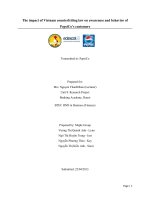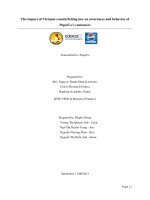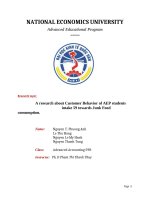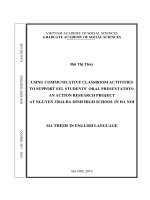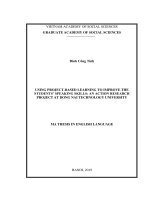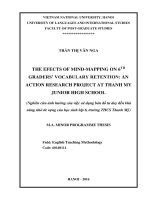522 Research Project ASSIGNMENT 2
Bạn đang xem bản rút gọn của tài liệu. Xem và tải ngay bản đầy đủ của tài liệu tại đây (1.45 MB, 36 trang )
Summative Feedback:
Grade:
Assessor Signature:
Internal Verifier’s Comments:
Signature & Date:
Resubmission Feedback:
Date:
Contents
I. Introduction...................................................................................................................................................10
II. Hypothesis....................................................................................................................................................10
III. Literature Review........................................................................................................................................10
3.1 KPI...........................................................................................................................................................10
3.2 Task Management...................................................................................................................................11
3.3 Promotion in Work.................................................................................................................................11
IV. Data Collection............................................................................................................................................12
1. Descriptive Data........................................................................................................................................12
2. Raw Data Collection..................................................................................................................................12
3. Cost............................................................................................................................................................12
V. Analyzation...................................................................................................................................................12
VI. Finding.........................................................................................................................................................21
VII. Discussion and Recommendations............................................................................................................24
7.1 Discussion...............................................................................................................................................24
7.2 Recommendations..................................................................................................................................25
VIII. Re-confirm hypothesis...............................................................................................................................26
IX. Pros & Cons..................................................................................................................................................27
X. Conclusion....................................................................................................................................................27
XI. References...................................................................................................................................................28
XII. Appendices................................................................................................................................................28
12.1 Result....................................................................................................................................................29
12.2 Question List.........................................................................................................................................35
Research Report
I.
Introduction
As the chief human resources officer in a multinational corporation, I recognize that businesses need to
take a more enduring approach and adhere to their talent acquisition policy. With the theme "The need
for innovative and innovative working methods to achieve a holistic approach to talent", is the basis for
research in this project. Theories learned to complete this research paper.
II.
Hypothesis
Hypothesis:
H1: Does setting KPI by month help employees to work better than setting KPI by year or not?
H2: Is employee time-based management more efficient instead of task-based management?
H3: Does the employee follow the promotion roadmap in specific jobs or rely on breakthrough projects to
promote?
Tittle: Management strategy to talent management
Method: Questionnaire
Access: Google Form, randomly (use Google to create survey)
III.
Literature Review
3.1 KPI
Encouraging and motivating employees regularly at work is an effective way to help you complete KPI
well, while contributing to optimal labor efficiency but also a way to motivate employees to work better.
Although the employees have only completed half of the KPI set, but the timely encouragement and
praise of the employees' efforts when looking at their work performance help them feel appreciated and
recognized the effort they put into. (acabiz, 2021)
For each specific score framework, the KPIs system developer identify each link between the evaluation
results and the specific remuneration levels. Depending on each department of titles, fields of activity ...
that managers perform the construction of flexible KPIs in steps and should hire experienced consultants
to combine with employees in the Company to targets put into use to promote high efficiency and are
consistent with the overall management goals of the Company, especially the goals in human resource
management (citisteel, 2021)
Managers use KPIs to control the completion of their employees' jobs. From that; giving each salary and
bonus regime most suitable for each item of work. Besides, there are disciplinary regulations and
directions to improve work efficiency (blog, 2019)
3.2 Task Management
Michael Hocking (2019) published a report on how to maintain the efficiency of employers and
employees. To develop talent management techniques that can move the talent management of an
organization past essential talent management processes, such as talent acquisition and effective
management, to the stage of talent growth. Well-managed, well-respected talent relationships and a
solid basis of talent.
Time management can help you become a more reliable employee who consistently completes
highquality work before the due date. This make you more valuable as a worker and improve your
professional reputation, which can help you find new opportunities to expand your career. (Freshbooks ,
2021)
With centralized task management points, it is possible to track and identify a team based on what they
are doing, determine how long on a task are on, and determine the team's effectiveness. Most tools
allow the user to manage a task visually and view the history of completed, pending, overdue, and
ongoing tasks. The reports generated by the tools can contain details such as start date, deadline, due
date, task budget, main task, side quests, and time allocation. (Techopedia, 2021)
3.3 Promotion in Work
Alfandi, Ashraf and Mohammad (2014) conducted a study to evaluate the role of various forms of
benefits in enhancing and improving employee performance.
Achie, Samuel and Joshua (2016) reveals that even as employees obtain cash benefits and advancement
prospects, they still struggle to satisfy the demands of employees. In order to maximize productivity,
businesses need to increase benefits across all types of workers.
The fight for top talent in the AEC and design disciplines has increased in both Canada and the UK. Hiring
requires a clear brand and value proposition. Employees are more negotiable and have higher
expectations than ever before. Companies must shape employees' experiences accordingly and provide
meaningful careers for the talents they want to attract, retain, and advance. These are considerations to
ensure your workforce becomes and remains competitive. (Innoviapartners, 2021)
A clear, goal-oriented approach to employee performance management should be adopted. Companies
need to balance the way they value, reward, and drive past performance with the need to focus
employees on professional development and improvement that match their role expectations. The
changing needs of business, personal interests and the potential of employees. An active, ongoing
approach to managing performance, providing employee feedback and support can help improve
individuals and organizations' performance (innoviapartners, 2021)
IV.
Data Collection
1. Descriptive Data
In order to ensure accuracy and transparency in my responses and to achieve the most controllable data,
I would use the questionnaire approach and to obtain more accurate information using a quantitative
system to give the workers and survey participants some options. In order to ensure that the findings are
appraisable, evaluated and easy to monitor, all questions are asked in closed questions. Both of these
used for the management and review of the problem on the basis of previously forecast results.
2. Raw Data Collection
I asked 15 related questions about the working environment and employee needs about KPI aspects,
management structure and specific promotion roadmap. The survey went on over 12 days and collected
30 responses via Google's form link.
3. Cost
The cost of this study is almost negligible on the basis of the Google features available. All
data/information obtained in Google form is free of charge and is saved by Google Documentary and
analyzed by myself.
V.
Analyzation
From collecting 31 responses of the survey, we have got:
All questions sponsored for all 3 hypotheses to enable the survey to be more reliable. I'm going to have
the first question to inquire for common skills and suggestions about the job environment. The remaining
questions broken down to help and reflect on each of them, as I described above.
With the chart for question 1: "Why is" Talent Management Strategy "so important to a company's
growth?", From the 31 answers provided, data are obtained for the first option The preparation and
selection of the quality of the employee accounts for 58.1%. The second option, the older ones faster
than teaching young people is 19.4%, and the third option is to retain the employees of the company to
avoid 'jumping on' 22.6%.
With the chart for question 2: "Do you think the KPI setting for your employees needs to change?", From
the 31 responses provided, obtained data for the first choice Yes is 61.3% and No is 38.7%.
With the chart for question 3, "If there is a change in the KPI settings, what do you think should be done
to improve and motivate employees to be more efficient ?, from the 31 responses provided, The data for
the first option divides the work and the required completion within a fixed time is 45.2%, the second
option is to provide support policies such as salary allowances and bonuses to improve morale.
employees is 19.4% The third option is to reduce the number of jobs by 12.9%, and finally the selection
for all of the above is 22.6%.
With the chart for question 4, "Do you want to work in monthly or yearly KPIs?" , from the 31 responses
provided, the data for the first choice by month was 51.6%, year-on-year at 35.5% and for the other at
12.9%.
With the chart for question 5, "Evaluate the effectiveness of your previous KPI setup on a scale of 1 to
5." , from the 31 provided responses, obtained data for the ineffective selection of 12.9%, inefficiency of
29%, efficiency of 25.8%, very efficiency of 19.4%, and extremely efficient selected staff is 12.9%.
With the chart for question 6, "For each KPI completion level, the KPI system builder had determine a
certain salary and bonus for employees, is it really necessary?" , from the 31 provided responses, the
data for which the Yes option was 77.4% and No was 22.6%.
With the chart for question 7, "Would you like to work on the amount of work completed in a day or the
time it takes to complete that task?", From the 31 responses provided , to obtain data for the first choice
is that employees like to do the amount of work completed in a day accounting for 38.7%. The second
option is that the employee likes 51.6% of the time to complete the task. Finally, the option for
employees who have the desire of both options accounts for 9.7%.
With the chart for question 8, "Does imposing time to complete an assigned task put you under
pressure?", From the 31 provided responses, obtained data for the selection. The first is that the
employee feels pressure accounts for 48.4%, the rest is that the employee does not feel pressured
accounting for 51.6%.
With the chart for question 9, "Are you the type of person who prefers to work individually or in
groups?", From the 31 responses provided, obtained data for the selection of employees who prefer to
work in groups accounting for 48.4% and employees who like to work individually account for 51.6%
With the chart for question 10, "Do you want a straightforward promotional direction that allows you to
work more confidently and patiently ?.", from the 31 provided answers, obtain data for the selection Yes
Account 64.5 % and choose No 35.5%.
With the chart for question 11, "If the company gave you a chance and challenge to get ahead in your job,
would you do it ?.", from the 31 provided answers, obtained data for the selection. choose employees
who agree to accept the request accounting for 51.6%. Employees who do not accept the request
account for 41.9%, and some employees have not thought and have not given the answer yet, accounting
for 6.5%.
With the chart for question 12, "To advance quickly at work has need a lot of courage and your own
efforts and efforts, do you think you can do it ?.", from the 31 provided responses, are obtained. 51.6% of
the data for choosing employees who agree to do their best, refuse because they feel their current job is
35.5% good, and some employees are not think given the answer is 12.9%.
With the chart for question 13, "If the company has a change in management strategy coming up, are you
adapt and accept that change ?.", from 31 responses provided, data for selection are obtained.
employees agree to accept change if the strategy is to bring many benefits to employees is 51.6%, the
percentage of employees who choose the job unchanged because they see the old strategy is inherently
good is 38.7% and the percentage of employees who stand between the two choices is 9.7%.
With the chart for question 14, "Do you like the monthly bonus, the quarterly bonus of the year or the
year-end bonus like the 13th salary ?.", from the 31 provided responses, obtained data. for the selection
of employees who prefer a quarterly bonus of the year is 54.8%, the percentage of employees who prefer
a year-end bonus is 29%, and employees prefer a monthly bonus of 16.1%.
With the chart for question 15, "What are your feelings and desires when you do this survey ?.", from the
31 answers provided, data were obtained for the selection of employees who felt comfortable because
They have met a lot of companies with such a change of 42.9%, the percentage of employees who are
happy because the change of company bring many benefits to employees is 39.3%, and at the end and
employees feel very excited because this change help employees and company achieve better results of
17.9%.
VI.
Finding
Based on the first chart, we can see the importance of talent management strategy in the company's
development, up to 58.1% of employees think that talent management strategy is very important.
Because this help the company be able to prepare and select qualified employees and give their best to
the company. 19.4% of employees think that accepting people with work experience help the company
shorten the staff training process than young and never experienced employees. The remaining 22.4% of
employees believe that the talent management strategy help the company retain employees, and avoid
the situation of employees "jumping jobs" in the current competitive working environment.
Charts from questions such as 2, 3, 4, 5, 6 support the first hypothesis that setting KPI by month helps
employees to work better to set KPI by year or not? Based on chart 2, showing the importance of placing
KPI in the current working environment, employees realize that changing KPI is really necessary to help
employees work effectively and effectively. More dedication, 61.3% of employees think that changing KPI
is really necessary in the current context, the remaining 38.7% of employees realize that changing KPI is
not really necessary. From the above results, it shows that the 2: 1 ratio of the KPI change helped the
majority of employees improve their productivity. This create positives and benefits for employees in
particular and the company in general. Based on chart 3, in the case if the company has a change in the
KPI setting, most employees think that the work should be clearly divided and required to be completed
within a certain time for this opinion is 45.2%. There is an opinion that the provision of supportive
policies such as salary and bonuses for promotion is agreed by the staff to 19.4%. Next is the opinion
given that should reduce the number of jobs, 12.9% of the staff agreed. Ultimately all of the above should
be done so that the employees do better at 22.6%. In this chart, it can be seen that most employees
choose what to do for them and forcing them to do a certain time is the thing that is addressed in the
company's talent management policy. More specifically, setting KPI for employees, employees want this
to easily achieve KPI from the company. Based on chart 4, there are 51.6% of the employees who want to
work according to KPIs per month, followed by 35.5% of the employees who want to work according to
the KPI of the year, and the rest is 12.9%. Students want to work according to other KPIs such as KPIs
based on the task or the amount of work completed. In this chart, most employees choose KPIs by
month, this is understandable because month by month helps employees to be more motivated to work
harder, get immediate benefits and quickly. They are not the type of work that waits for recognition on
their accomplishments throughout the year. Setting KPI by month help the company to have a quality
working team and help employees and the company achieves the benefits in it. Based on chart 5, the
assessment of the effectiveness of the company's previous KPI setting, receiving most of the opinions of
employees rated on a scale of ineffectiveness to extremely effective, first of all 12.9 % of employees rate
that the company's previous KPI is ineffective, 29% rate of employees rated as ineffective, up to 25.8%
rate of employees seeing the efficiency, 19.4% rate of employees members found it very effective and
12.9% of the staff thought it was extremely effective. The chart shows that the ratio of inefficiency
including inefficiency is 41.9% of the employee rating, and the remaining 58.1% of employees agree with
the previous KPI setting brings many benefits to Staff. However, the disagreement is not significant, but
the difference is so low, bringing nearly half the percentage of employees who are not really satisfied
with what the company brings through the form of KPI setting. In chart 6, there is great consensus here
for the "Yes" selection. Up to 77.4% of employees find that for each KPI completion level, the employee
received a certain salary and bonus, the rest rate of employees choosing "No" is 22.6%. In this chart,
most employees like to work if they receive certain rewards for their effort, which is evident in the
employee's mentality. Employee performance bonuses helped employees work proactively and maximize
their capabilities compared to their nothing.
Charts from questions such as 7, 8, and 9 support the second hypothesis, which staff is time-based or
task-based, which is really effective in the management strategy? In Figure 7, up to half of employees,
accounting for 51.7%, say they like to work on a time basis, meaning that they need time to get the job
done. Next 38.7% of employees like to be done according to the amount of work that they can complete
in a day. The remaining 9.7% of the staff members give the two above opinions. It can be seen that the
imposition of employees according to the number of jobs not help the talent management strategy
achieve the expected efficiency. The proportion of employees who prefer to complete their work based
on time can be what employees are really needed to help them not feel the pressure of the company on
the employees. In Figure 8, if it is to put pressure on employees to get the job done in a given time,
48.4% of the employees say they feel pressured if the company does so, the rest. 51.6% of employees
said that they do not feel pressured. However, this 2 ratio is almost 1: 1, the company needs to make
changes in the management strategy so that employees can easily access the talent management
strategy. In chart 9, in order to improve if employees feel pressured, the company come up with suitable
strategies to improve that, the percentage of employees who prefer to work in groups is 48.4% and the
percentage of employees like to do personal work is 51.6%. Show that the majority of employees like to
work individually, but they also like to work in groups. The company needs the combination of these two
working methods to help employees work better.
Charts from questions such as 10, 11, 12, 13, and 14 supports the third hypothesis for employee
promotion, so it should be based on a specific roadmap or projects to help employees break through. In
chart 10, most employees want to have a detailed and clear roadmap for their advancement in the job,
the percentage of employees who want to have the direction to help them advance in the company. job
is 64.5%, in addition, the percentage of employees who work without orientation is 35.5%. In chart 11,
where companies question their employees to help them advance faster through challenges and
opportunities, the majority of employees are 51.6% willing and able to do it, followed by 41.9% of
employees declined because they did not need that need, and 6.5% of the staff did not give an answer. It
can be seen that the need to work and the need to be promoted in the employees is high, because they
are always working and are willing to give their all to the company, but in return the employees need
recognized through promotion. To achieve promotion opportunities, employees need to go through a
challenging work process. In this chart, employees are willing to accept the challenge to capture
advancement opportunities in their work. In chart 12, the company shows that if an employee wants a
promotion it takes a lot of effort, but this not make it difficult for the employee because the percentage
of employees who choose to do it the very best job is 51.6%, the percentage of employees choosing to
refuse because they think their current job is good, the rest have not given answers, accounting for
12.9%. In chart 13, the company's management strategy change bring many changes in the company, but
employees can still adapt and change accounting for 51.6%, in addition to the proportion of employees
not change because for them the change created many problems accounting for 38.7%, and ultimately
9.7% of employees stand between these two decisions. In Figure 14, employees who like to work and are
rewarded quarterly for the year account for 54.8%, the percentage of employees who like to be rewarded
by year is 29%, and in the end, the lowest percentage is employees who like to be rewarded monthly.
16.1%. In this chart, it can be understood that, in order to motivate employees to go to work and
approach the promotion roadmap, the bonus must go hand in hand with the employee's efforts can be a
lever to help employees work hard. to be rewarded and promoted.
Finally, on the chart for question 15, the company gave the options to survey the employee's feelings
when doing this survey, most of the employees felt normal because they had experienced it. Many
companies have such changes, followed by a part of employees who feel very happy because they see
that the company cares about more employee benefits than before, accounting for 39.3%, and 17.9% of
employees feel that very excited because this helped the company and its employees both achieve better
benefits and results.
VII.
Discussion and Recommendations
7.1 Discussion
In today's competitive working environment, talent management is becoming an increasingly important
factor to promote the growth of businesses. If corporate policies do not bring many benefits to
employees, it is obvious that employees want to stick for the company for a long time, that is not
possible. I realize that talent management includes many aspects, in order to do this well, businesses
need to pay attention to the needs and wants of employees. If the company has a good talent
management strategy, employees will work and are willing to give their best, on the contrary, employees
has not work well if the company has good talent management regimes. Therefore, based on many
candidates' answers, as well as my observations, most businesses have not performed well their talent
management strategy. Because most businesses are still focusing on growth, they are ignoring many
policies to compensate employees. But if a business wants to develop in the long run, the factor of having
a good employee is still the most important factor.
About 10 years ago talent management focused primarily on talented people and the manager's role and
how their influence affects lower-level employees, as opposed to HR management. focus on the life cycle
of each employee in the organization. Talent management has an enormous role and responsibility in
anticipating the human resources needed and planning to meet that need through the recruitment,
development and engagement process. In some organizations, only the top employees are in the talent
management system. Elsewhere, all employees are involved in the process. In some companies, the
talent management system is accessible through software engineering, others through meetings
between the talent's direct manager and the human resource manager. Meanwhile, with HR
management, all candidates and employees need attention and attention. Meetings between employees'
direct managers and human resources are also less likely under the HR management system, except in
some special cases. In addition, HR management is less of a long-term strategy like talent management.
(HKT CONSULTANT, 2019)
In an increasingly fierce competition environment and especially in many erratic and uncertain business
contexts, businesses need to stand firm and promote their competitive advantages in order to survive
and thrive. If an enterprise wants to stand firm, its internal strength must be strong. However, at present,
the situation of employees thinking about jobs and changing jobs in key industries is very large.
Specifically, according to Anphabe's "The Tale of the Departures" survey, the percentage of people
thinking of continuous increases in Vietnamese companies reached 20.5% in 2018. Specifically, for the IT
industry, according to the report "Current situation of IT human resources and recruitment plan to meet
new technology" of Navigos Gruop, 45% of employees said that they are not satisfied with the salary and
bonus regime, 40% have no chance of promotion. For the manufacturing industry, according to research
by Navigos Search has just published with a report called "Portrait of human resources in manufacturing
industry: challenges and opportunities in Industry 4.0". The reason why employees think jobs are 49%
due to salary, welfare and 43% is due to promotion is not clear. According to this report, for the majority
of employees, salary, bonus (62%) and promotion mechanism (44%) are still the most important factors
to keep them in the company, after that new issues of boss or work environment.
Disadvantages of management strategies in talent management strategies, changing management
strategy structure to bring more benefits to employees, helping employees get more benefits when
working and promotion opportunities clearly. This is obviously have part of the impact on the business
having to spend a huge amount of money and time operating and applying change structures to all
employees.
7.2 Recommendations
Experience to retain employees for the business, the first thing promotion is a milestone in the career of
individuals and organizations, is a worthy reward for those who are capable and achieve good job
performance. Learn and evaluate the effectiveness of what employees have done, discover new skills
they want to expand. From there, you should create opportunities for them to develop, promote and
